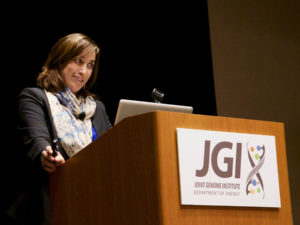Team finds surface microbes are colonizing the deep subsurface.

While this is not one of the wells used in the study, it does show what a site looks like during the drilling process. (Image courtesy of the MSEEL (Marcellus Shale Energy and Environment Laboratory www.mseel.org), where the Wrighton Lab is also conducting research.)
The Science
Through a collaborative science program involving two DOE national user facilities, DOE-supported researchers have been able to reconstruct microbial genomes for the first time from shale formations that are being drilled to extract natural gas. Coupled with microbial metabolic information, the data shed light on the impacts of hydraulic fracturing on microbial communities in the deep subsurface, and has insights on the sustainability of energy extraction through this approach.
The Impact
Microbes play key roles in maintaining the planet’s biogeochemical cycles, and while the economic benefits and environmental impacts are being studied, less attention has been focused on the impacts to the deep subsurface and the salt tolerant microbial communities therein.
Summary
By 2040, shale formations are expected to be the source of half of all the natural gas used in the United States. Extracting these natural gas reserves requires hydraulic fracturing, or “fracking.” While the economic benefits and environmental impacts are being studied, less attention has been focused on the impacts to the deep subsurface and the microbial communities therein. To answer that question, a team led by the Ohio State University’s Kelly Wrighton compared microbial communities from the Marcellus shale in the Appalachian Basin, which is expected to produce triple the amount of natural gas sourced from any other shale formation, and from the Utica, a shale formation in Ohio.
For the first time, the team reconstructed 31 microbial genomes from the fractured shale and studied their metabolic interactions for nearly a full year. This work was accomplished in partnership with two user facilities stewarded by the Office of Biological and Environmental Research within DOE’s Office of Science: the DOE Joint Genome Institute (DOE JGI) at Lawrence Berkeley National Laboratory (Berkeley Lab), and the Environmental Molecular Science Laboratory (EMSL) at Pacific Northwest National Laboratory through a collaborative science initiative called Facilities Integrating Collaborations for User Science (FICUS).

Kelly Wrighton at the 2016 DOE JGI Genomics of Energy & Environment Meeting
As fracking involves injecting fresh water along with chemicals and other fluids deep into the earth, the team found that microbes from the surface were also being injected and colonizing the deep subsurface, 2.5 kilometers underground and thus affecting the resident microbial community in unknown ways. “This study highlights the resilience of microbial life to adapt to, and colonize, a habitat structured by physical and chemical features very different from their origin.” The study appeared online September 6, 2016 in Nature Microbiology.
Kelly Wrighton spoke about her FICUS project at the DOE JGI 2016 Annual Genomics of Energy & Environment Meeting. Watch her talk at http://bit.ly/JGI2016Wrighton.
Contacts
Daniel Drell, Ph.D.
Program Manager
Biological Systems Sciences Division
Office of Biological and Environmental Research
Office of Science, US Department of Energy
daniel.drell@science.doe.gov
Paul Bayer
Program Manager
Climate and Environmental Sciences Division
Office of Biological and Environmental Research
Office of Science, US Department of Energy
Paul.Bayer@science.doe.gov
Kelly Wrighton
Ohio State University
wrighton.1@osu.edu
Funding
- DOE Office of Science
- National Science Foundation Dimensions of Biodiversity
- Sloan Foundation
Publications
- Daly R et al. Microbial metabolisms in a 2.5-km-deep ecosystem created by hydraulic fracturing in shales. Nat Microbiol. 2016 September 6. doi:10.1038/nmicrobiol.2016.146: http://www.nature.com/articles/nmicrobiol2016146
Related Links
- http://jgi.doe.gov/microbial-diversity-deep-shale/
- http://jgi.doe.gov/user-program-info/community-science-program/how-to-propose-a-csp-project/emsl/
- Video: http://bit.ly/JGI2016Wrighton
- The Ohio State University news release: https://news.osu.edu/news/2016/09/05/new-genus-of-bacteria-found-living-inside-hydraulic-fracturing-wells/